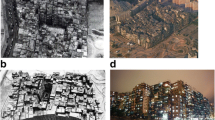Abstract
The complex urban environment has multiple levels of design and planning that are applied in the form of blocks, layouts and city patterns. This paper develops an analytical study based on urban residential blocks in Ningbo city in China. It explores issues of density, green infrastructures, and urban quality with particular focus on environmental performance. At what point does exaggerated density reduce both living qualities and opportunities for good climatic design and a low carbon footprint? The study applies a simple methodology to evaluate and compare planning options for residential areas. The goal is pragmatic, seeking not ideal solutions but realistic and inexpensive alternatives to current practice which is particularly inefficient in terms of energy and climate emissions. Some potential advantages of low-dense as compared to high-rise solutions are noted. The study highlights questions as to optimal or appropriate typologies and densities for sustainable cities, in particular in the fast expanding cities of developing countries.
















Source: Authors.


Similar content being viewed by others
References
Akbari, H., Pomerantz, M. and Taha, H. (2001) Cool surfaces and shade trees to reduce energy use and improve air quality in urban areas. Solar Energy 70(3): 295–310.
Burgess, R. (2000) The Compact City Debate: A Global Perspective, In Jenks, M. and Burgess, R. (eds.) Compact Cities, Sustainable Urban Form for Developing Countries. London and New York: Spon Press.
Butters, C. et al (eds.) (2010) Signals: Local action-success stories in sustainability, Oslo: Stiftelsen Idebanken (The Ideas Bank Foundation), see also www.vauban.de.
Butters, C. and Cheshmehzangi, A. (2016) Sustainable Cities: Reconsidering China’s Urban Residential Policies. in press.
Chen Y. and Wong N.H. (2006) Thermal benefits of city parks. Energy and Buildings, 38: 105–120.
Cheung, J.O.P. and Liu, C.H. (2011) CFD simulations of natural ventilation behaviour in high-rise buildings in regular and staggered arrangements at various spacings. Energy and Buildings, 43: 1149–1158.
Cole, R.J. (2012) Regenerative design and development: current theory and practice. Building Research & Information, 40 (1): 1–6.
Galvez, L.H. and Cheshmehzangi, A. (2015) China’s urban housing: The review of three studied typologies and patterns, In proceedings of the 6th Urban Space and Social Conference, 6–9 June 2015, Macau.
Givoni, B. (1998) Climate Considerations in Building and Urban Design. New York: Van Nostrand Reinhold.
Hahtela, T., Holgate, S., Pawankar, R., Akdis, C.A., Benjaponpitak, S., Caraballo, L., Demain, J., Portnoy, J. and von Hertzen, L. (2013) The Biodiversity Hypothesis and Allergic Disease: WAO Position Statement, World Allergy Organisation Journal, 6, p. 3, London.
Hanski, I., von Hertzen, L., Fyhrquist, N., Kaskinen, K., Laatikainen, T., Karisola, P., Auvinen, P., Paulin, L., Makela, M.J., Vartiainen, E. Kosunen, T.U., Alenius, H. and Haahtela, T. (2012) Environmental biodiversity, human microbiota, and allergy are interrelated. In Proceedings of the National Academy of Sciences.
Jabareen, Y.R. (2006) Sustainable urban forms, their typologies, models, and concepts. Journal of Planning Education and Research 26: 38–52. (MIT, Association of Collegiate Schools of Planning).
Kockelman, K.M. and Nichols, B. (2014) Urban Form and Life Cycle Energy Consumption: Case Studies at the City Scale. University of Texas: Austin.
Kwok, A. and Grondzik S.W. (2007) The Green Studio Handbook: Environmental Strategies for Schematic Design. Burlington: Elsevier.
LSE Cities/EIFER. (2014) Cities and Energy: Urban Morphology and Heat Energy Demand, Final Report, London.
Ningbo Annual Statistics Yearbook. (2013), China Statistics Press.
Olgyay, V. and Olgyay, A. (1963) Design with Climate. Princeton: Princeton University Press.
Saito, I., Ishihara, O. and Katayama, T. (1990–1991) Study of the effect of green area on the thermal environment in an urban area. Energy and Buildings, 15/16:493–498.
Steemers, K. (2003) Energy and the city: Density, buildings and transport. Energy and Buildings, 35: 3–14.
Wang, Y., Bakker F., de Groot R. and Wörtche H. (2014) Effect of ecosystem services provided by urban green infrastructure on indoor environment: A literature review. Building and Environment, 77: 88–100.
Yang, J. (2010) Does energy follow urban form? An examination of neighborhoods and transport energy use in Jinan, China. Masters Thesis, MIT, Cambridge.
Zhang, X. Q. (1999) High-Rise and High-Density Compact Urban Form: The Development of Hong Kong. Centre of Urban Planning and Environmental Management, University of Hong Kong, Hong Kong, p. 244.
Zhang, X., Platten A. and Shen, L. (2011) Green property development practice in China: Costs and barriers. Building and Environment 46: 2153–2160.
Zhang, B., Xie, G., Gao, J. and Yang, Y. (2014) The cooling effect of urban green spaces as a contribution to energy-saving and emission-reduction: A case study in Beijing, China. Building and Environment 76: 37–43.
Acknowledgements
This study is an output from a UK funded research program for the benefit of developing countries. The views expressed are not necessarily those of the funders DFID, EPSRC and DECC. The program, on Energy and Low Income Tropical Housing (ELITH), includes a broad scope of housing and community research in both rural and urban areas of China, Thailand, Tanzania and Uganda.
Author information
Authors and Affiliations
Corresponding author
Rights and permissions
About this article
Cite this article
Cheshmehzangi, A., Butters, C. Chinese urban residential blocks: Towards improved environmental and living qualities. Urban Des Int 22, 219–235 (2017). https://doi.org/10.1057/s41289-016-0013-9
Published:
Issue Date:
DOI: https://doi.org/10.1057/s41289-016-0013-9




